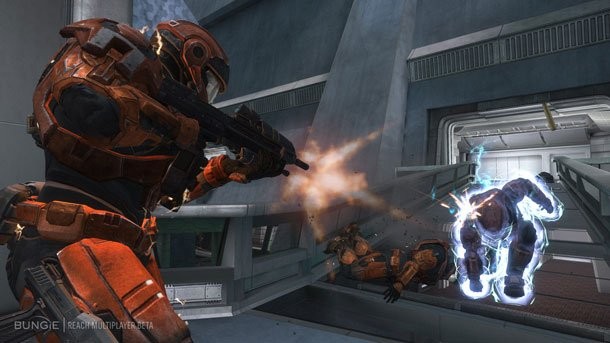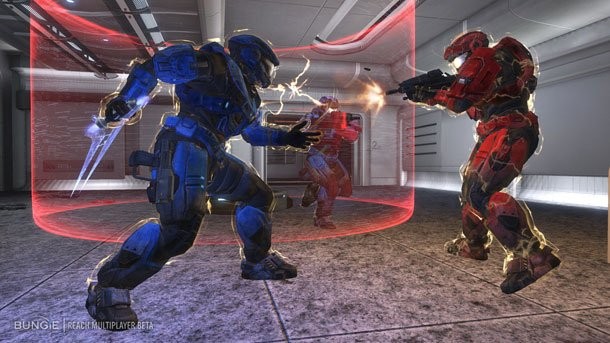Please support Game Informer. Print magazine subscriptions are less than $2 per issue
Halo Reach
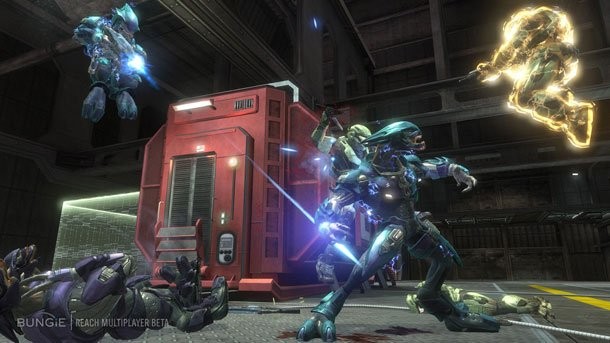
The wait is almost over. In less than two weeks Halo fans will have an opportunity to try out Bungie’s new formula for competitive multiplayer. It is arguably the most important component to Halo’s success: While the franchise’s extensive lore and Master Chief’s unwavering ability to kick ass have made the series popular, it’s the continued support of its millions of online players which has elevated the series to epic status. Last week on the day that the Halo 2 servers were finally shut down for good, Bungie gave us the chance to try the next chapter in Halo’s multiplayer firsthand. While the basic controls remain largely the same, the new armor abilities, gameplay modes, and intricate reward system make for a completely new experience. Here are some of the things you’ll see on May 3.
[UPDATE]: Added tons more screenshots to the image gallery. Also, for those interested: Bungie confirmed the multiplayer beta will also feature split-screen multiplayer. Generator Defense mode will be restricted to 2-player split-screen, while all other modes will support full 4-player split-screen.

Armor Abilities:
The biggest addition to Halo’s gameplay are armor abilities, reusable powers that work on cooldown timers and accommodate different styles of gameplay. Armor abilities are tied to load outs: Each load out combines two weapons with one armor ability, and they are swappable every time you spawn.
We’re not sure how many armor abilities will be available in the main game, but the beta will feature five different options. All of the abilities feel adequately balanced, but certain ability/gun combinations can be extremely powerful. Here are the armor abilities you’ll be using in the beta:
Sprint: This ability is available only to Spartans. As the name suggests, it gives players the ability to sprint for a short period of time. Although it’s not as cool as some of the other abilities, Sprint can be invaluable in some game modes or when you’re trying to run down an enemy for a morale-depleting assassination kill. I couldn’t shake the feeling that sprint should be available for all players like in most shooters, but at least it’s an option some of the time.
Active Camo: Like the Active Camo power-up in previous Halo games, this ability makes your character invisible for a short amount of time. The slower you move, the harder you are to detect, and Active Camo has the added bonus of jamming the radar of nearby enemies (as well as your own). I used this ability the least during my play time, but more stealth-minded players will probably make good use of it.
Armor Lock: This ability creates a force field around the player that is completely impenetrable by any form of attack. If that sounds unfair, there's a catch: The player is also immobile when they use Armor Lock and cannot use any weapons, making it a purely defensive maneuver. So what good is Armor Lock if you can’t move or fire weapons while using it? It can save you from a lunging energy sword or gravity hammer attack, for one. It can also block slower weapons like the rocket launcher, giving you time to attack while your enemy is reloading. Armor Lock also releases a localized EMP burst when it disperses, disabling the shields of anyone waiting to thump you when the ability wears off.
Evade: Evade is an Elite-only ability and is in some ways the counterpart of the Spartan’s Sprint. Evade makes an Elite dive into a roll, much like they do in the single player game. It’s surprisingly useful for dodging enemy fire (especially at close range), and it can also be used to evade weapons with lock-on capabilities.
Jet Pack: It’s a jet pack. It allows you to fly around a level -- what more do you need to know? The jet pack was by far the most popular ability during the preview event, and can be a serious game changer. Also, floating just above an enemy while they futilely wave a gravity hammer at you? Priceless.
Next we'll take a look at the new game types featured in the Halo: Reach multiplayer beta.
New Modes:
In addition to trying out Halo’s new moves, we also got a chance to try the beta’s new multiplayer modes. Last week we went over the basic rules of each new game type, but weren’t allowed to share our impressions until today. Here’s what we thought.
Generator Defense: This was the first mode Bungie showed us, referring to it as “Network Test 1” -- a sign that the mode is still very much in development. In the beta, Generator Defense will only feature 3v3 matches; Bungie said that may change in the final release (if the mode makes it into the retail game at all). Generator Defense reminded me of a stripped down version of Battlefield: Bad Company 2's Rush mode, with one team attacking three different generators on a map, while the other team defends them.
One key difference is that the generators can be locked down, making them temporarily invulnerable to attack. The other aspect that made this mode feel unique (and this is true of the beta as a whole), is how much the various armor abilities affect gameplay. Each match plays out completely differently if you or your opponent’s team is flying in on jet packs, sneaking behind targets with Active Camo, or camping near generators with Armor Lock. There’s definitely a new rock-paper-scissors element to the gameplay that makes Halo’s multiplayer more addictive than ever before.
Invasion: The biggest map in the beta (and the only one to feature vehicles) was made for Invasion mode. Invasion is Bungie’s take on objective-based competitive gaming. One team will play as the Spartans, and the other team will play as Elites. The Elites must complete three objectives within a given amount of time. The first two involve storming and capturing points (i.e. standing in glowing areas for a certain amount of time). The third objective is a little like capture the flag: The Elites must steal a "Data Core" and bring it back out of the base to their awaiting Covenant ship.
Spartans, on the other hand, only have to stop the Elites from progressing while they wait out the timer. One interesting aspect about Invasion is that the load outs get increasingly more powerful during each phase -- not only will you have deadlier weapons at your disposal, but you’ll unlock vehicles as well. Whether I was playing as the Spartans or Elites, the end of each round was always a manic fight over the last bit of territory.
Stockpile: Stockpile is a new take on CTF. Each team has a colored zone on opposite ends of the map. Four neutral flags are placed randomly in the level. Your goal is to grab one of the flags and return it to your zone. The catch? Flags are only converted into points at specific intervals during the round -- a timer will tick down over your zone to let you know how close you are to collection. This means not only do you have to collect the flags, but you have to defend them until the timer expires, lest a group of the opposing team comes in and steals your stockpile before you score. While an individual can still score a lucky point here and there, those who forgo teamwork will usually get trounced by a coordinated opposition. When two competent teams face off against each other, matches end up being extremely tight.
Headhunter: Out of all the modes I played, Headhunter was my favorite. It reminded me of American Gladiators’ Powerball event, except instead of running balls to a goal, you’re carrying flaming skulls ejected from the bodies of dead players. Unlike Halo’s skull-oriented Oddball mode, you can carry more than one skull at a time, and you can still use your weapons and armor ability while you’re carrying them. Points are scored when you walk into one of two scoring zones, which randomly move around the level. Headhunter is the most chaotic mode we played during our preview of the beta; the temptation to swoop in on someone else’s kill proved impossible to resist, oftentimes leading large groups of opponents to pool in a central area, showering the environment in flaming skulls as everyone killed one another.
Up next: The maps of the Halo: Reach multiplayer beta.

The Maps:
The multiplayer beta will include four maps, two of which are mode-specific, while the other two are open to a variety of game types. Bungie has stated that you will be able to create and upload saved films in the beta. During the preview, they also revealed that the Forge editor mode will be included in Halo: Reach but will not be available in the beta. Here are the four maps:
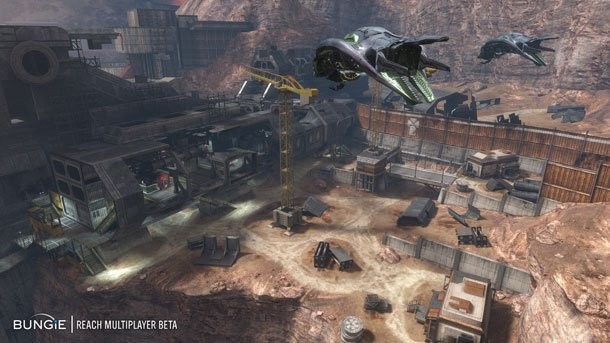
Boneyard: This is the largest map of the beta, and is restricted to Invasion mode. It is the only map in the beta to include vehicles. It is roughly the size of Halo 3’s Sandtrap map, but features much more detail.
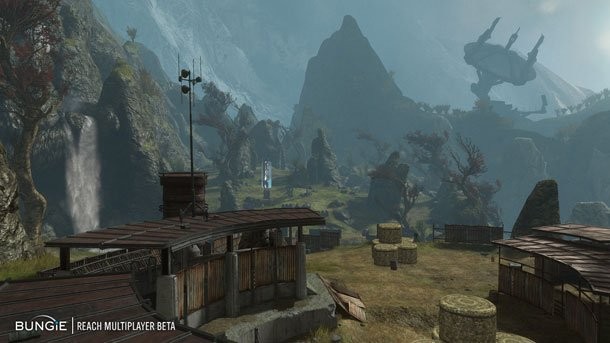
Overlook: For the beta, Overlook is restricted to the Generator Defense game type. Overlook is taken from the first level of the campaign, and provides surprisingly detailed backgrounds which no longer employ the use of sky boxes.

Powerhouse: The first of the two maps that supports multiple game types, Powerhouse is a civilian power station featuring several indoor environments in addition to the large outdoor area pictured above. The map is split down the middle by a shallow river, which really doesn’t affect gameplay at all but looks hella pretty.

Swordbase: Swordbase also features a variety of game modes. It is similar to the original Halo’s Boarding Action map, featuring two multilevel buildings that share a central corridor. While the various rooms on each level can be claustrophobic (be sure to pack your shotgun or energy sword), the main corridor opens the door to vertical gunplay for those players sporting the jet pack.
While four maps and a handful of modes may not sound like a lot, I was pleasantly surprised by how much gameplay the Halo: Reach multiplayer beta offers. The variety between modes kept the maps from getting old and made it hard to put the controller down. You’ll also get a chance to try out the new reward system, which allows you to unlock new customization options for your multiplayer character (don’t worry, they’re aesthetic only, and unlocks won't carry over into the retail version). The beta is definitely more than a glorified demo.
Whether or not longtime Halo fans will like all of the changes Bungie has made to their multiplayer formula remains to be seen, but if you’ve grown tired of the franchise’s more traditional take on FPS action, the beta might just offer the breath of fresh air you’ve been waiting for.
For more information on Halo: Reach's multiplayer, check out the June issue of Game Informer.
